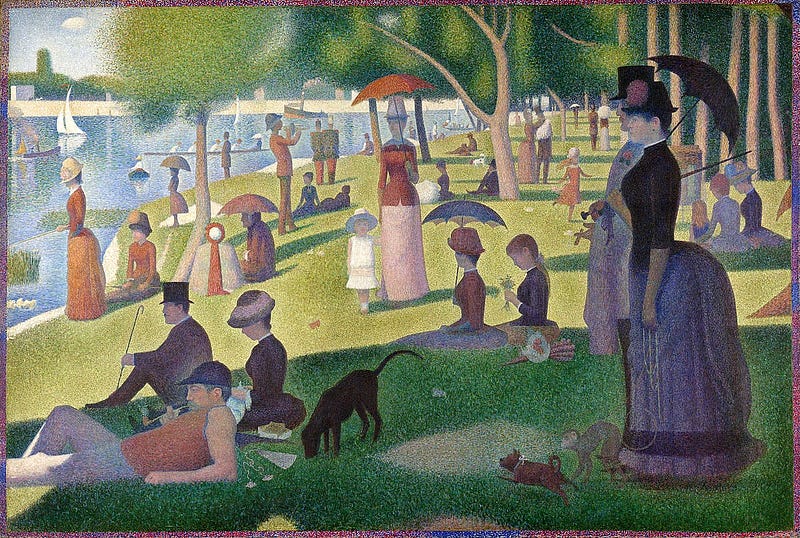Exploring the Depths of Consciousness and Existence
Written on
Contemplating the Nature of Consciousness
According to Stephan Schwartz, remote viewing is the capacity to tap into nonlocal consciousness to gather information not derived from physical proximity. However, defining nonlocal consciousness poses challenges akin to those encountered in understanding consciousness itself. It raises the notion that our sense of self might transcend physical existence. This idea has been articulated through various languages and practices, including the ancient yogic traditions of Siddhis in Sanskrit. Schwartz argues for a framework that can delineate this nonphysical aspect of existence, suggesting that our linguistic approach to these experiences is evolving. Is there a need for new terminology to better engage with these phenomena?

An article from Rutgers titled Beliefs about the Soul and Afterlife that We Acquire as Children Stick with Us suggests that our belief systems, both individually and collectively, are largely static and shaped by culture. If this were entirely true, the evolution of ideas would be impossible. Typically, we hold onto beliefs that serve us until they become untenable, and sometimes we abandon functional beliefs simply because they fall out of favor.
I contend that this perspective overlooks the transformative experiences many individuals undergo that shift their belief systems, leading to novel understandings of existence and the afterlife.
Transpersonal Therapy would not have gained acceptance in psychology if transcendent experiences were not acknowledged.
The realms of mediumship, psychic phenomena, Near Death Experiences, and remote viewing studies, alongside spiritual practices from various traditions like Tibetan Buddhism and whirling Dervishes, all suggest that life encompasses more than what is immediately perceivable. Practitioners in these fields offer methodologies that can be replicated, not just anecdotal evidence.
Scientific investigations into monks have revealed notable distinctions in their brain activity and physiological states compared to those who do not engage in meditation or related practices. Prior to the 1970s, the capabilities of monks were dismissed as fanciful. It was once thought that humans could not consciously regulate autonomic functions, as these were deemed automatic and involuntary. However, we have since learned that humans can achieve far more with their minds and bodies than previously imagined. Technologies like biofeedback and neural feedback are now making the experiences of monks accessible to a broader audience.
Herbert Benson's 1970s book, The Relaxation Response, is among many works that empower individuals to take charge of their health and well-being. Had we pursued this line of thought with the same financial commitment as pharmaceutical research over the past five decades, we might have fostered a healthier population and heightened our collective sense of spirituality. Those who meditate or practice biofeedback often encounter the 'magic' of altered states.
Numerous authors have engaged with this 'phenomenon', including Ian Stevens, Robert Monroe, Thomas Campbell, Carl Jung, and many others. This is by no means an exhaustive list, nor is it organized by recommendation; inclusion here signifies that the author has read and appreciates their contributions.
In the video below, Schwartz articulates:
"I cannot tell you what consciousness is, nor can anybody else. But what I can tell you is it seems very clear from the research… and let me emphasize this with you, Alex, that I am a data person. I am not interested in, I am not a philosopher, I am not a theoretician, I don’t speculate. What I like is objectively verifiable, hard data. I am an experimentalist. And if you look at the hard data from those large range of fields, what you discover is that the evidence that there is an aspect of consciousness that is not physiologically based, and that’s irrefutable."
Schwartz's data suggests that part of our self exists beyond our physical lives. His views resonate with those of Raymond Moody and Michael Newton, positing that we have an existence prior to birth and continue beyond death, framed within what he calls "information architecture," which echoes the themes of the film The Matrix.
Heaven by Any Other Name
According to Schwartz, our physical existence, comprising body and mind, is a manifestation of consciousness. This notion challenges the materialistic perspective that confines us to being solely physical entities with consciousness arising from neuronal activity. Our lives do not unfold in isolation but within a continuum of consciousness that interlinks all living beings, where harm to one species reverberates across all, including humanity.
Each species embodies a facet of consciousness, which does not imply distinct beings but suggests that, just as the human brain exhibits various brainwave states, universal consciousness encompasses diverse states. Plant consciousness, for instance, while part of the overall system, operates at a unique frequency. Given the interdependence of all life forms, this frequency may be foundational, permeating others. Brainwave states, too, are interconnected rather than isolated.
The entire cosmos is said to resonate at B flat.
Within and beyond our physical existence, human consciousness intertwines with other forms of consciousness, which may not be human in nature, yet still connect within a broader spectrum. Data indicates that awareness can exist outside the confines of human experience.
Edgar Mitchell, an Apollo 14 astronaut, experienced profound unity on his return journey to Earth, leading him to establish the Institute of Noetic Sciences (IONS) to study such experiences, rather than starting a new religion.
What have these explorations uncovered? Evidence suggests that consciousness or awareness encompasses dimensions far beyond our current understanding. Perhaps materialist viewpoints downplay consciousness because it is so expansive that it becomes overwhelming for any individual or group to fully comprehend.
Life is too vast to be reduced to a singular concept; however, one could assert that we are unified as one entity—whether that be the universe, God, or consciousness itself.
Oh, the Places You Will Go
Schwartz envisions an eternal self that, perhaps in solitude or alongside other beings, cultivates a personality and subsequently manifests a physical form to express that personality, akin to programming software for a computer. This eternal self operates within an informational architecture.
Michael Newton’s book, Journey of Souls, wrestles with this very structure.
Heaven might be likened to a Dr. Seuss library—strange, whimsical, yet functional and enjoyable. One might envision heaven as a harmonious space where kindness prevails. I would argue that this is largely accurate. To assert that Earth exists outside of God or consciousness is a contradiction and touches upon the substantial truth within that assertion.
It's akin to claiming that humans can exist without plants, bacteria, or other forms of life. Without a planet, without conflict and disagreement.
Souls, as reference points within a matrix of data, inherently seek evolution. The entire system likely desires to evolve. For evolution to occur, every perspective within that framework must also progress. Thus, souls create new reference points, or personalities, necessitating a space to explore the consequences of their "programs."
Thomas Campbell suggests that Earth serves as a training ground for evolving personalities, with the core program focusing on love—defined by relationships that aim for the highest good of others and the collective system.
As reference points essential for enhancing relationships, personalities offer a valuable approach. Interactions devoid of personalities resemble mechanical functions. Souls are not mere cogs; they embody awareness. Personalities, akin to hats, facilitate interactions among different personalities or soul awareness points within specific contexts.
These "hats" are crucial; one generally would not share as openly with a stranger on a bus as with a therapist. The therapist's role establishes the framework and boundaries of interaction, ideally providing attentive and compassionate guidance.
It would seem ludicrous if commuters at a train station suddenly burst into a spontaneous dance, only to resume their routines afterward. Yet, our affinity for music has led to the creative phenomenon of flash mobs, momentarily lifting us from our mechanical lives.
Yes, the world could resemble a Bollywood film, bursting into song amidst rain or roses, but such moments require a context that allows for their emergence.
Thus, many souls collectively designed Earth. It serves as a consensus reality where all occurrences unfold according to a plan, albeit with the paradox of free will. Perhaps the original intention was chaos, as humanity seemed intent on hitting rock bottom. The years 1999 and 2012 sparked a realization: this extraordinary life is not as grim as anticipated, prompting a willingness to journey further.
Along the way, we may have recognized that catastrophe is not the sole teacher; we can learn through vicarious experiences. Fiction offers ample insights into both the potential darkness and light of existence. When confronted with apocalyptic narratives, it’s possible that ancient prophets were glimpsing alternate realities or interpreting visions without the necessary context to comprehend their significance.
Remote viewers often perceive fragments. Imagine a mystic 2,000 years ago catching a glimpse of Chernobyl—witnessing an invisible destruction that would render an area uninhabitable for millennia. Lacking the vernacular of the time, Chernobyl is translated into "wormwood." Many have misinterpreted this, thinking the Ukrainian term refers to a medicinal herb. In reality, "Chornobyl" pertains to mugwort, Artemisia vulgaris, not wormwood, which is A. absinthium.
Yet, we persist in maintaining destructive visions because they resonate within our consciousness. We can hold the awareness of devastation while aspiring towards healthier ways of existing. Stories of love and growth emerge from Earth. It stands to reason that we need not conclude humanity's saga on a tragic note.
However, every world eventually reaches an end. Somewhere, a reality is fading, potentially welcoming a new soul.
Numerous worlds inhabit the realms of consciousness, as documented throughout history. The "mansions" or "many houses" mentioned by Jesus might signify these worlds. They could be starships or nonphysical realms mirroring our own.
From my speculative viewpoint, the physical realm resembles a vast sandbox where we collectively strive to manifest our true home. This earthly existence will always be a limited mimicry—not lesser, but a space for creative learning. We make mistakes here to minimize errors elsewhere.
Indeed, errors can occur in those realms as well. The paradise that was Earth in its inception would not have faltered if we were not prone to missteps.
Conversely, if our actions are merely explorations of diverse existences, then everything becomes a valuable data point for future inquiries and discoveries.
We learn from our miscalculations by recognizing their impact on the larger system. Though we may be singular points of perspective in a grand scheme, akin to quarks within an atom, each point contributes to the whole, much like every element on a mobile affects its balance. Adjusting the weight of one element shifts the entire structure, necessitating either a new equilibrium or a reconfiguration of weights.
You are the center of your universe, just as every other soul occupies that same position, with God perceiving all through the eyes of every soul that constitutes Her. Your perspective and emotions hold significance. Everything about you matters because you influence the dynamics of all others.
And so, here we are, together, reflecting on the universe. What transformations have we initiated? What revelations? What love? What errors? What sorrows?
One atom of carbon alone does not create a diamond; rather, it is a collection of carbon atoms under specific conditions of pressure, temperature, and time that forms a diamond.
A metaphor for the validity of all personalities and reference points in the grand design:

Recommended:
- Is Fiction Writing a Form of Remote Viewing
- When authors predict the future…
- solarchariot.medium.com
- Remote Viewing the Future
- The good news, there is a future!
- solarchariot.medium.com